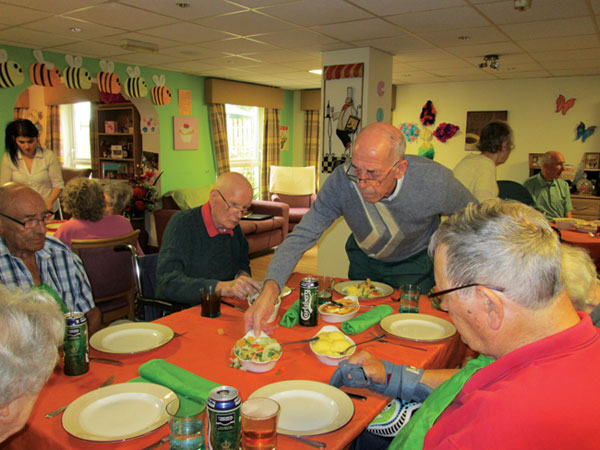Public sector focus: How the Butterfly model for emotional-based care helps dementia patients
Small changes, such as allowing care home residents to eat what and when they want, can mean happier residents and improved job satisfaction for carers, says Dr David Sheard. Janet Harmer joins in on one of his training sessions
Sitting down alongside care home residents and eating brightly coloured food within a fun, homely setting should be the focus of all caterers who provide a service for people with dementia, according to a leading expert in the field.
Anyone who has experience of friends or relatives who have been diagnosed with dementia will fully understand the commonsense approach outlined in the Butterfly approach of offering emotionally based, as opposed to task-orientated, care.
The reality is that with the increasing stresses upon the care system, which is now overwhelmed by the demand for places from an increasingly aging population, the focus is usually a world away from the Butterfly model. The
number of people living with dementia in the UK is set to rise from 850,000 today to over one million by 2025, so the pressure on care homes to provide the most appropriate type of care is set to become ever greater.
Frustrated with the lack of emotional care available for dementia sufferers,
dementia care specialist Dr David Sheard launched the concept of Butterfly
homes after setting up his consultancy, Dementia Care Matters, in 1995.
The starting point, explained Dr Sheard, has to be with the recruitment of staff who can tap into their own emotional history. "If we are going to have a chance of creating wellbeing among dementia residents, you've got to have carers who get it," he says. "It is not just about producing great food; it is also about connecting with and reaching people. Any effort on good nutrition is wasted unless the resident feels at home."
Dr Sheard explained that catering for dementia sufferers often requires the carers and catering staff to stop being logical; for instance, allowing the resident to pour a drink over a main course before eating. "There is a need to change attitudes. Don't think patients are doing something wrong just because it isn't the norm."
The result of such an approach has proved to have positive results time and time again, with families reporting improved happiness among loved ones; weight loss being stemmed and, in some cases, replaced by weight gain; food wastage down by up to 70%; fewer falls being recorded; and staff speaking of improved job satisfaction.
Since attending Dr Sheard's training session, Sophie Murray, head of nutrition and hydration at Sunrise Senior Living and Gracewell Healthcare and deputy chair of the NACC, says the company has piloted a new dining model that will include ways to emotionally engage staff with residents.

n it comes to the key elements of the Butterfly model of care, Murray says there could be challenges with regards to the level of staffing, especially if the decision makers in the businesses have not fully bought into the model.
"Existing staff cultural change is always a challenge, but powerful training and role modelling helps this aspect, as do clear working models," she says.
While Murray acknowledges that the availability of full meals at all times might not always be practical across the 27 Sunrise and 16 Gracewell homes, she says there is an 'always available' menu and plans are made for individual residents.
"We have basic cooking facilities within kitchenettes, so food can be prepared, cooked and served by care staff, who all have basic food safety training," she adds.
Dr Sheard concluded that any effort by caterers to provide the most nutritious meal possible is wasted unless the patient feels safe within an environment they
regard as home.
"Catering for dementia patients is not just about the right ingredients," he says. "The best thing you can do after this course is to go back to your workplace and fight for establishing the right culture."
The Butterfly model in practice
Landermeads Care Home near Nottingham is one of 100 to have adopted the Butterfly model and one of six to have received an 'outstanding' rating from the Care Quality Commission (CQC). The CQC inspection report, dated December 2016, highlights the innovative methods used by staff to encourage people who
were reluctant to eat or drink.
"Tables were set and displayed invitingly and contained a range of interesting and stimulating activities, including books, flowers and snacks to encourage people to sit at the table. People were offered a minimum of two choices of meal, or staff prepared another meal if requested.
"We saw that staff and people using the service sat together to eat their meals. People were sat in small groups of their own choosing, with plenty of positive,
happy, lively conversation. We noted that staff were supporting one person with their meal and saw this was done with dignity and discreetly, while still allowing
the person to engage in conversation with their friends."
For Anita Astle, owner of the Wren Hall nursing home, also near Nottingham, adopting the Butterfly model in 2010 was an extension of the home's policy of providing people-centred care.
"When it comes to catering, we focus on what people enjoy and are familiar with, engaging residents in as much of the preparation of the food as possible," she said. "Last night the residents chopped the vegetables for a vegetable lasagne and they recently got involved in the preparations for Pancake Day. Being involved increases the feeling of wellbeing for residents."
Once a month families are invited to Wren Hall to enjoy a five-course meal with their loved ones, an occasion the 53 residents love. "It normalises everything -
residents feel secure surrounded by their families, they eat well and have a laugh," says Astle.
Wren Hall's kitchen is headed by double award-winner Malcolm Shipton. He was named NACC Care Chef of the Year in 2011 and Premier Foods' Dysphagia Chef of the Year in 2016.
The mealtime experience - the Butterfly way
Orientation - around 45 minutes prior to a meal, residents should be prepared through cooking smells, discussing, looking at pictures of food, laying tables and encouraging involvement in food preparation. All of these activities, alongside encouraging physical activity and fresh air, will help increase appetite and, potentially, achieve weight gain.
Meal quality and content - the best quality dining experience and standard of food will show that people are valued. Healthy, nutrient-rich snacks should be provided for people who tend to overeat, while the use of herbs and spices will help stimulate taste, which can diminish for people with dementia.
Enriched food should be provided for those with a poor appetite, by the addition, for instance, of butter, cream, cheese, milk powders, full-fat milk and extra sugar, as well as the use of high-energy supplement drinks.
Finger foods should be provided for people with dexterity issues. Allow for the mixing of unusual food combinations, such as providing sweet and savoury foods, and promote bright and contrasting food colours.
Sociability and atmosphere - mealtimes should be a social occasion free from other distractions and not a task. Staff should eat alongside residents and keep conversations going during mealtimes in order to improve appetites. This can be done by using objects and photos. Soothing and positive music will add to the enjoyment of eating, as will colourful crockery and tablecloths. A family-style, homely atmosphere is the goal, with staff uniforms banned in order to create a more inclusive atmosphere.
Visual choice - food and drink choices should be shown at the time of the meal, and residents encouraged to serve themselves and each other at the dining table.
Food availability - food should be visible and available 24 hours a day, to encourage people to eat when they feel like it. Usual mealtimes should be extended for those who eat slowly and/or small portions should be given throughout the day. Coloured liquids should be available in addition to water, as they are more noticeable to residents.
Assessment - the weight of every resident should be recorded and the appropriate nutrition plan put in place. Assessments should be carried out with regards to the ability to chew and swallow, or any pain suffered during eating, which may require the need for puréed food. Other considerations include the most suitable type of drinking cups, and cultural and religious beliefs.











